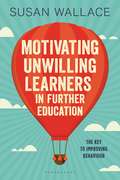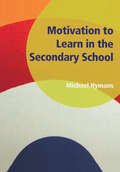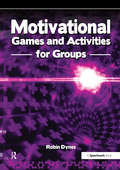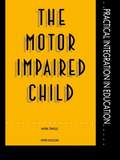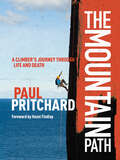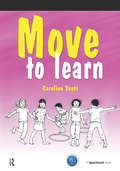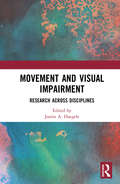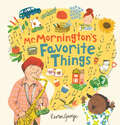- Table View
- List View
Motivating Reluctant Learners: Practical Strategies for Raising Attainment
by Roger NorgateThe materials in this book are the product of work undertaken by Hampshire Psychology Service in collaboration with 22 primary and secondary schools to address the needs of children whose academic motivation was proving particularly problematic. The five year project involved feedback and review sessions which helped refine the programme. There are four sections: Information on attribution theory and its application in the classroom; Practical issues on implementing the programme; Support for staff including a PowerPoint training session; The 12 session pupil programme including facilitator notes. The programme is designed to give pupils experience of success at the same time as encouraging them to attribute the success to their own effort, skills and strategies. It helps them to understand: ability is not fixed; learning is difficult for everyone and requires effort; the significance of using strategies including help-seeking and self-talk; the important of taking responsibility and setting SMART goals. Participating staff reported changes in pupils: the course effected a significant change and they moved into Year 10 options far more positive and motivated. And also in themselves: I thought the theory was one of the best things ...it was as if a light bulb had been turned on. I have really gained in confidence as a consequence. This pack contains a CD ROM with copiable activities, DVD clips of pupil intervies and using the programme, an example of a pupil booklet and the PowerPoint presentation.
Motivating Reluctant Learners: Practical Strategies for Raising Attainment
by Roger NorgateThe materials in this book are the product of work undertaken by Hampshire Psychology Service in collaboration with 22 primary and secondary schools to address the needs of children whose academic motivation was proving particularly problematic. The five year project involved feedback and review sessions which helped refine the programme. There are four sections: Information on attribution theory and its application in the classroom; Practical issues on implementing the programme; Support for staff including a PowerPoint training session; The 12 session pupil programme including facilitator notes. The programme is designed to give pupils experience of success at the same time as encouraging them to attribute the success to their own effort, skills and strategies. It helps them to understand: ability is not fixed; learning is difficult for everyone and requires effort; the significance of using strategies including help-seeking and self-talk; the important of taking responsibility and setting SMART goals. Participating staff reported changes in pupils: the course effected a significant change and they moved into Year 10 options far more positive and motivated. And also in themselves: I thought the theory was one of the best things ...it was as if a light bulb had been turned on. I have really gained in confidence as a consequence. This pack contains a CD ROM with copiable activities, DVD clips of pupil intervies and using the programme, an example of a pupil booklet and the PowerPoint presentation.
Motivating the Teenage Mind
by Eva Hoffman Martin HoffmanAwakening intrinsic motivation in young people is the most important key to securing them a meaningful and successful life. No matter how much we know about how to learn, no lasting learning is likely to take place unless we want to learn; unless we are convinced of the reasons and have the confidence and resilience to achieve our goals. "Motivating the Teenage Mind" is a unique, comprehensive, practical, activity-based motivational programme for secondary students. It will give every student an opportunity to recognise their strengths, awaken their aspirations and become aware of the reasons for learning, and show them how to confidently create a vision for their future lives. The programme provides educators with seven key aspects of motivation: making and giving choices; awakening curiosity and interest; nurturing dreams and setting goals; making learning relevant; raising confidence; strengthening resilience; and rewarding achievement. Aimed primarily at 11-16 year old secondary pupils, this resource is also suitable for 16-18 year old college students.
Motivating Unwilling Learners in Further Education: The key to improving behaviour
by Susan WallaceThe overriding issue for many Further Education teachers and trainees is learner disengagement, leading to behavioural issues and a lack of motivation in the classroom. Faced with unmotivated learners on a daily basis, teachers can soon begin to lose their own enthusiasm and confidence. Motivating Unwilling Learners in Further Education offers a range of practical strategies for engaging your learners and reigniting the spark of successful classroom teaching.Susan Wallace draws on her years of teaching and researching in Further Education to provide an up-to-date selection of strategies and scenarios for managing behaviour and motivating unwilling learners, including tips forsupporting students and meeting curriculum requirements. This is a valuable toolkit of ideas and advice for ensuring that everyone you teach, from school leavers to mature students, reaches their full potential.
Motivating Unwilling Learners in Further Education: The key to improving behaviour
by Susan WallaceThe overriding issue for many Further Education teachers and trainees is learner disengagement, leading to behavioural issues and a lack of motivation in the classroom. Faced with unmotivated learners on a daily basis, teachers can soon begin to lose their own enthusiasm and confidence. Motivating Unwilling Learners in Further Education offers a range of practical strategies for engaging your learners and reigniting the spark of successful classroom teaching.Susan Wallace draws on her years of teaching and researching in Further Education to provide an up-to-date selection of strategies and scenarios for managing behaviour and motivating unwilling learners, including tips forsupporting students and meeting curriculum requirements. This is a valuable toolkit of ideas and advice for ensuring that everyone you teach, from school leavers to mature students, reaches their full potential.
Motivation to Learn in the Secondary School
by Michael HymansTeachers have an enormous impact on how their students approach learning situations. Motivation to Learn in the Secondary School provides the opportunity for senior management teams to enhance learning and teaching by looking at theories of motivation and then relating these to the realities of the classroom. The book looks at the role of senior leaders and how they can encourage their staff to: explore the role that student-teacher relationships play in encouraging student motivation; highlight the importance of emotional literacy for motivating teaching and learning; explore a range of ideas to nurture motivation for the promotion of effective teaching and learning, such as accelerated learning, learning styles, multiple intelligences, meta-cognition and thinking skills. Each chapter shows how the concepts and theories convert into practice. These are identified throughout the book as TiPs (Theory into Practice) to: aid understanding of the model; encourage student motivation through particular practices. There are 38 TiPs, which include activities with handouts and information pages. These are designed for individual and/or groups of staff to use for reflection and development of action plans to promote student motivation to learn.
Motivation to Learn in the Secondary School
by Michael HymansTeachers have an enormous impact on how their students approach learning situations. Motivation to Learn in the Secondary School provides the opportunity for senior management teams to enhance learning and teaching by looking at theories of motivation and then relating these to the realities of the classroom. The book looks at the role of senior leaders and how they can encourage their staff to: explore the role that student-teacher relationships play in encouraging student motivation; highlight the importance of emotional literacy for motivating teaching and learning; explore a range of ideas to nurture motivation for the promotion of effective teaching and learning, such as accelerated learning, learning styles, multiple intelligences, meta-cognition and thinking skills. Each chapter shows how the concepts and theories convert into practice. These are identified throughout the book as TiPs (Theory into Practice) to: aid understanding of the model; encourage student motivation through particular practices. There are 38 TiPs, which include activities with handouts and information pages. These are designed for individual and/or groups of staff to use for reflection and development of action plans to promote student motivation to learn.
Motivational Games and Activities for Groups: Exercises to Energise, Enthuse and Inspire
by Robin DynesHow can you encourage people to be motivated? How can you create that sense of yearning to achieve or reach a goal? How can you energise and inspire group members? The exercises and activities in this resource will help you to motivate your team or the group with which you are working. The activities are organised in sections from which you can choose to meet particular group needs. These include: Ice breakers and warm ups; Trust building; Building self-esteem; Inspiring creativity; Aligning values; Creating an inspiring environment; Becoming solution focused; Perception; Resilience; Team building; Visualising and setting goals; Energy boosters; Overcoming anxiety and fear; Managing stress; Stopping procrastination; and; Using competition. Whether your group is small or large you will find something for any setting. Many of the activities can also be used on a one-to-one basis in supervision, with clients or students. The activities are interactive and fun. Trainers, youth leaders, counsellors, group leaders, team managers, teachers, care workers and probation officers will find the resource one in which they constantly dip for inspiration. Robin Dynes is the Social Inclusion Officer for Skills & Learning in his local authority. His main role has been to develop an innovative outreach curriculum that is accessible and meets the needs of people with disabilities, older people and others who are vulnerable. The aim is to ensure that people with disabilities have equal opportunity and an active and fulfilling role within the community.
Motivational Games and Activities for Groups: Exercises to Energise, Enthuse and Inspire
by Robin DynesHow can you encourage people to be motivated? How can you create that sense of yearning to achieve or reach a goal? How can you energise and inspire group members? The exercises and activities in this resource will help you to motivate your team or the group with which you are working. The activities are organised in sections from which you can choose to meet particular group needs. These include: Ice breakers and warm ups; Trust building; Building self-esteem; Inspiring creativity; Aligning values; Creating an inspiring environment; Becoming solution focused; Perception; Resilience; Team building; Visualising and setting goals; Energy boosters; Overcoming anxiety and fear; Managing stress; Stopping procrastination; and; Using competition. Whether your group is small or large you will find something for any setting. Many of the activities can also be used on a one-to-one basis in supervision, with clients or students. The activities are interactive and fun. Trainers, youth leaders, counsellors, group leaders, team managers, teachers, care workers and probation officers will find the resource one in which they constantly dip for inspiration. Robin Dynes is the Social Inclusion Officer for Skills & Learning in his local authority. His main role has been to develop an innovative outreach curriculum that is accessible and meets the needs of people with disabilities, older people and others who are vulnerable. The aim is to ensure that people with disabilities have equal opportunity and an active and fulfilling role within the community.
The Motor Impaired Child (Practical Integration In Education Ser.)
by Mrs Myra Tingle Myra TingleThe Motor Impaired Child provides a wealth of information and practical guidance for teachers on both the social and educational implications of impairment. Issues covered include working with parents, physical disability in childhood, and the problems posed by limited mobility. Practical advice is given on the integration of impaired children in the classroom, and the final sections focus on how a motor impaired child may be helped through adolescence towards independent adulthood.
The Motor Impaired Child
by Mrs Myra Tingle Myra TingleThe Motor Impaired Child provides a wealth of information and practical guidance for teachers on both the social and educational implications of impairment. Issues covered include working with parents, physical disability in childhood, and the problems posed by limited mobility. Practical advice is given on the integration of impaired children in the classroom, and the final sections focus on how a motor impaired child may be helped through adolescence towards independent adulthood.
The Mountain Path: A climber's journey through life and death
by Paul Pritchard‘All I wanted to do was go to sleep. And I was certain that if I did drift off, it would be for the last time.’In 1998, Paul Pritchard was struck on the head by a falling rock as he climbed a sea stack in Tasmania called the Totem Pole. Close to death, waiting for hours for rescue, Pritchard kept himself going with a promise that given the chance, he would ‘at least attempt to live’.Left hemiplegic by his injury, Pritchard has spent the last two decades attempting to live, taking on adventures that seemed impossible for someone so badly injured while plumbing the depths of a mind almost snuffed out by his passion for climbing.Not content to simply survive, Pritchard finds ways to return to his old life, cycling across Tibet and expanding his mind on gruelling meditation courses, revisiting the past and understanding his compulsion for risk. Finally, he returns to climb the Totem Pole, the place where his life was almost extinguished.The Mountain Path is an adventure book like no other, an exploration of a healing brain, a journey into philosophy and psychology, a test of will and a triumph of hope.
Mouse and the Storm: Children’s reflexology to reduce anxiety and help soothe the senses (PDF)
by Melissa Muldoon Susan QuayleMouse and her animal friends are rudely disrupted from the comfort of their homes by a big storm! Waking up away from home, together they must find their way back despite feeling scared and lost. Written in rhyme along with easy-to-follow diagrams and instructions for giving simple hand reflexology to a child, this book will help parents soothe children, especially those who experience anxiety or have sensory regulation difficulties. Beautiful illustrations accompany the reflexology techniques which are easy to use to provide a calming experience to a child. No prior reflexology knowledge is required.
Mouth and Tongue Let's Have Some Fun!
by Karina HopperLearning new facial expressions and mouth movements can be great fun, just ask Sam! Moving the tongue and mouth in different ways is an effective way of strengthening facial muscles, teaching children about emotions and encouraging speech. Children will love copying Sam and Timmy Tongue's faces and improving their facial strength and dexterity.
Move to Learn
by Caroline ScottMasses of activities based on the premise that movement, particularly if it is specific and intentional, enhances learning. "Move to Learn" is a movement programme for children aged five to eight years, delivered in sessions, working one-to-one with an adult or as a small group. Use the programme to liven up a day, provide a 'brain break' in the curriculum or as a complete change for a pupil who is having an emotionally challenging day. Moving promotes learning and other outcomes will follow: Emotional - encouraging happy, secure, confident, motivated and positive emotional states in the limbic system of the brain to support a sense of well-being; Cognitive - using movement to create and strengthen neural pathways, to integrate brain activity and develop 'whole brain' learning; Motor - enabling children to develop their gross and fine motor skills, and to understand being active or calm and to know the difference; Social - using activities to have fun and play together, and to interact and build good relationships; and, Language - to encourage good listening skills and attending to instructions, and to learn to use self-talk to mediate learning. The activities are arranged in ten sections to address different types of movement: Stamina; Large motor actions; Mobility; Balance; Body awareness; Spatial awareness; Dexterity; Fine motor skills; Rhythm and sequence; and, Relaxation. This title includes six sample lesson plans and forms for children's evaluation, parents' evaluation, teachers' questionnaire and parents' questionnaire.
Move to Learn
by Caroline ScottMasses of activities based on the premise that movement, particularly if it is specific and intentional, enhances learning. "Move to Learn" is a movement programme for children aged five to eight years, delivered in sessions, working one-to-one with an adult or as a small group. Use the programme to liven up a day, provide a 'brain break' in the curriculum or as a complete change for a pupil who is having an emotionally challenging day. Moving promotes learning and other outcomes will follow: Emotional - encouraging happy, secure, confident, motivated and positive emotional states in the limbic system of the brain to support a sense of well-being; Cognitive - using movement to create and strengthen neural pathways, to integrate brain activity and develop 'whole brain' learning; Motor - enabling children to develop their gross and fine motor skills, and to understand being active or calm and to know the difference; Social - using activities to have fun and play together, and to interact and build good relationships; and, Language - to encourage good listening skills and attending to instructions, and to learn to use self-talk to mediate learning. The activities are arranged in ten sections to address different types of movement: Stamina; Large motor actions; Mobility; Balance; Body awareness; Spatial awareness; Dexterity; Fine motor skills; Rhythm and sequence; and, Relaxation. This title includes six sample lesson plans and forms for children's evaluation, parents' evaluation, teachers' questionnaire and parents' questionnaire.
Movement and Visual Impairment: Research across Disciplines
by Justin A. HaegeleThis is the first book to offer an in-depth review of research pertaining to individuals with visual impairments across the full span of movement-related disciplines, from biomechanics and motor learning to physical education and Paralympic sport. Each chapter highlights current research trends, future research directions, and practical implications in a key discipline or area of professional practice, drawing on empirical research evidence and opening up new avenues for cross-disciplinary working. Covering physical activity across the life course, from children and young people through to older adults, and addressing the important topic of deafblindness in some depth, the book goes further than any other book published to date on visual impairment and movement. This is essential reading for all advanced students and researchers working in sport, exercise and disability, and an invaluable reference for practitioners and service providers, from in-service teachers and camp directors to physical therapists and physical activity promotion specialists.
Movement and Visual Impairment: Research across Disciplines
by Justin A. HaegeleThis is the first book to offer an in-depth review of research pertaining to individuals with visual impairments across the full span of movement-related disciplines, from biomechanics and motor learning to physical education and Paralympic sport. Each chapter highlights current research trends, future research directions, and practical implications in a key discipline or area of professional practice, drawing on empirical research evidence and opening up new avenues for cross-disciplinary working. Covering physical activity across the life course, from children and young people through to older adults, and addressing the important topic of deafblindness in some depth, the book goes further than any other book published to date on visual impairment and movement. This is essential reading for all advanced students and researchers working in sport, exercise and disability, and an invaluable reference for practitioners and service providers, from in-service teachers and camp directors to physical therapists and physical activity promotion specialists.
Moving Mountains: Writing Nature through Illness and Disability
by Louise KenwardA first-of-its-kind anthology of nature writing by authors living with chronic illness and physical disability WITH A FOREWORD BY SAMANTHA WALTON Through twenty-five pieces, the writers of Moving Mountains offer a vision of nature that encompasses the close up, the microscopic, and the vast. From a single falling raindrop to the enormity of the north wind, this is nature experienced wholly and acutely, written from the perspective of disabled and chronically ill authors. Moving Mountains is not about overcoming or conquering, but about living with and connecting, shifting the reader's attention to the things easily overlooked by those who move through the world untroubled by the body that carries them. Contributors: Isobel Anderson, Kerri Andrews, Polly Atkin, Khairani Barokka, Victoria Bennett, Feline Charpentier, Cat Chong, Eli Clare, Dawn Cole, Lorna Crabbe, Kate Davis, Carol Donaldson, Alec Finlay, Jamie Hale, Jane Hartshorn, Hannah Hodgson, Sally Huband, Rowan Jaines, Dillon Jaxx, Louise Kenward, Abi Palmer, Louisa Adjoa Parker, Alice Tarbuck, Nic Wilson
Moving On: Supporting Parents of Children with Special Educational Needs
by Allison OrphanFirst Published in 2004. Routledge is an imprint of Taylor & Francis, an informa company.
Moving On: Supporting Parents of Children with Special Educational Needs
by Allison OrphanFirst Published in 2004. Routledge is an imprint of Taylor & Francis, an informa company.
Mploy – A Job Readiness Workbook: Career Skills Development for Young Adults on the Autism Spectrum and with Learning Difficulties
by Michael P. McManmonThis ready-to-use workbook provides everything you need to help young people with autism or learning differences prepare for work. Suitable for those working with young adults aged 16-26, this workbook includes activities and worksheets designed to develop key skills for meaningful careers, so young people can enter employment with confidence.
Mr Mornington's Favourite Things
by Karen GeorgeMy friend Mr Mornington has always lived next door to us. His favourite things are gardening and eating cherry cake and playing his saxophone. He's not the best rememberer, though.A little girl lives next door to Mr Mornington, who has played saxophone all over the world. These days, he's a bit tired of all that travelling, so now he plays it just for her. Together, they have a favourite song: one that conjures up memories of all their favourite things. But when Mr Mornington moves into a care home, his young friend wonders if he'll be able to remember her – or any of his favourite things at all... perhaps there's something she can do to help?This heartfelt and gently humorous picture book explores the subject of dementia in an original way. Drawing on themes of music therapy and the value of community and intergenerational friendship, it has a warm yet realistic ending that will help readers to process their own feelings of loss.Includes Mr Mornington's famous cherry cake recipe at the back of the book, so you can try one of his favourite things.
Muffin the Fish: Targeting the f Sound (Speech Bubbles 1)
by Melissa PalmerMuffin is a quirky little fish full of fun ideas. What will he get up to next? This picture book targets the /f/ sound, and is part of Speech Bubbles 1, a series of picture books that target specific speech sounds within the story. The series can be used for children receiving speech therapy, for children who have a speech sound delay/disorder, or simply as an activity for children’s speech sound development and/or phonological awareness. They are ideal for use by parents, teachers or caregivers. Bright pictures and a fun story create an engaging activity perfect for sound awareness. Please see other titles in the series for stories targeting other speech sounds.
Muffin the Fish: Targeting the f Sound (Speech Bubbles 1)
by Melissa PalmerMuffin is a quirky little fish full of fun ideas. What will he get up to next? This picture book targets the /f/ sound, and is part of Speech Bubbles 1, a series of picture books that target specific speech sounds within the story. The series can be used for children receiving speech therapy, for children who have a speech sound delay/disorder, or simply as an activity for children’s speech sound development and/or phonological awareness. They are ideal for use by parents, teachers or caregivers. Bright pictures and a fun story create an engaging activity perfect for sound awareness. Please see other titles in the series for stories targeting other speech sounds.


